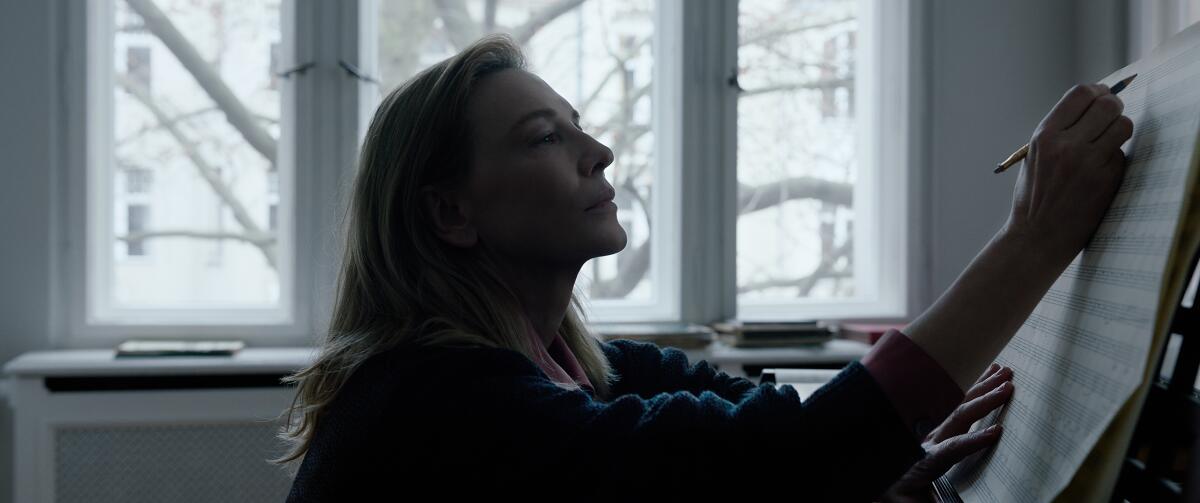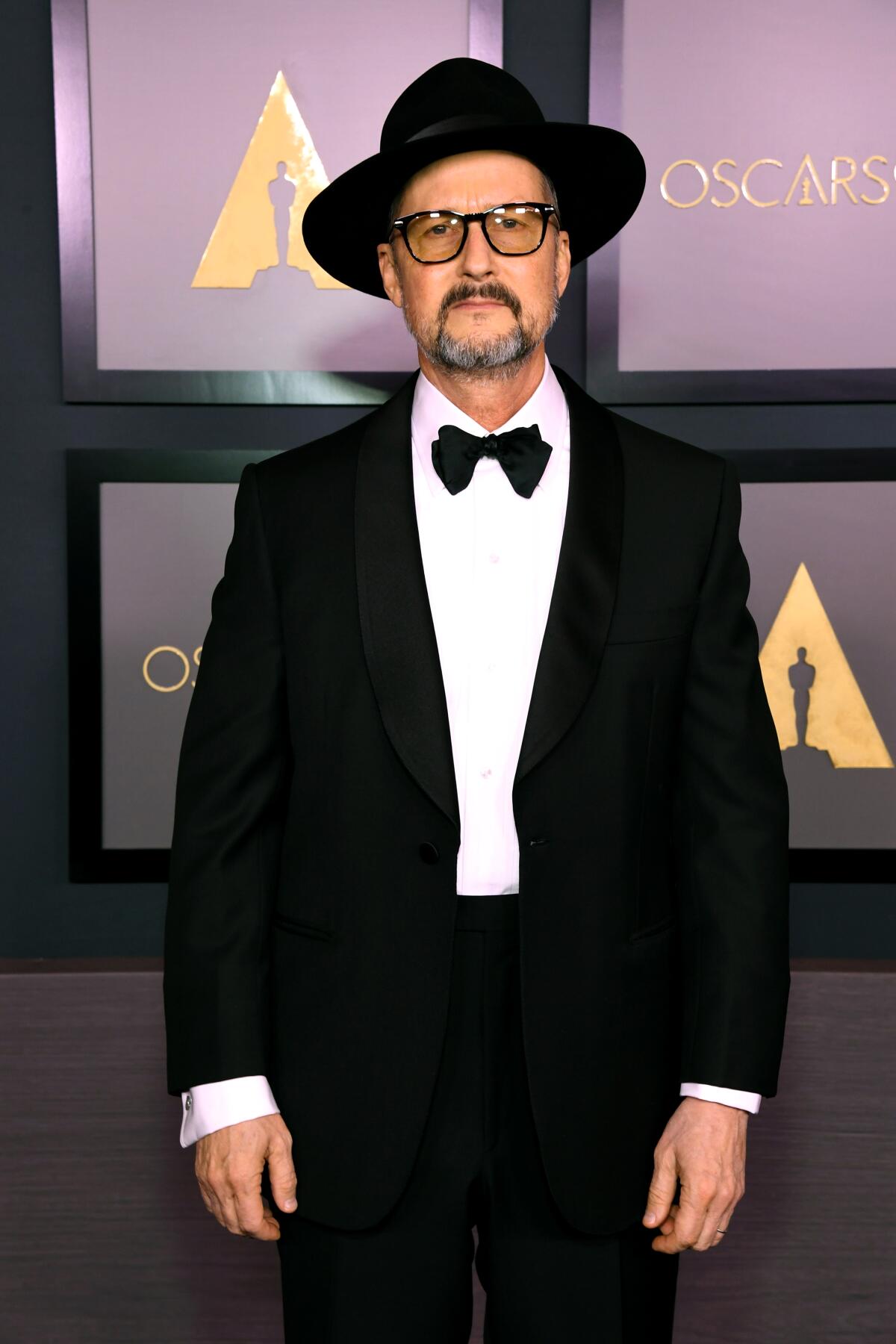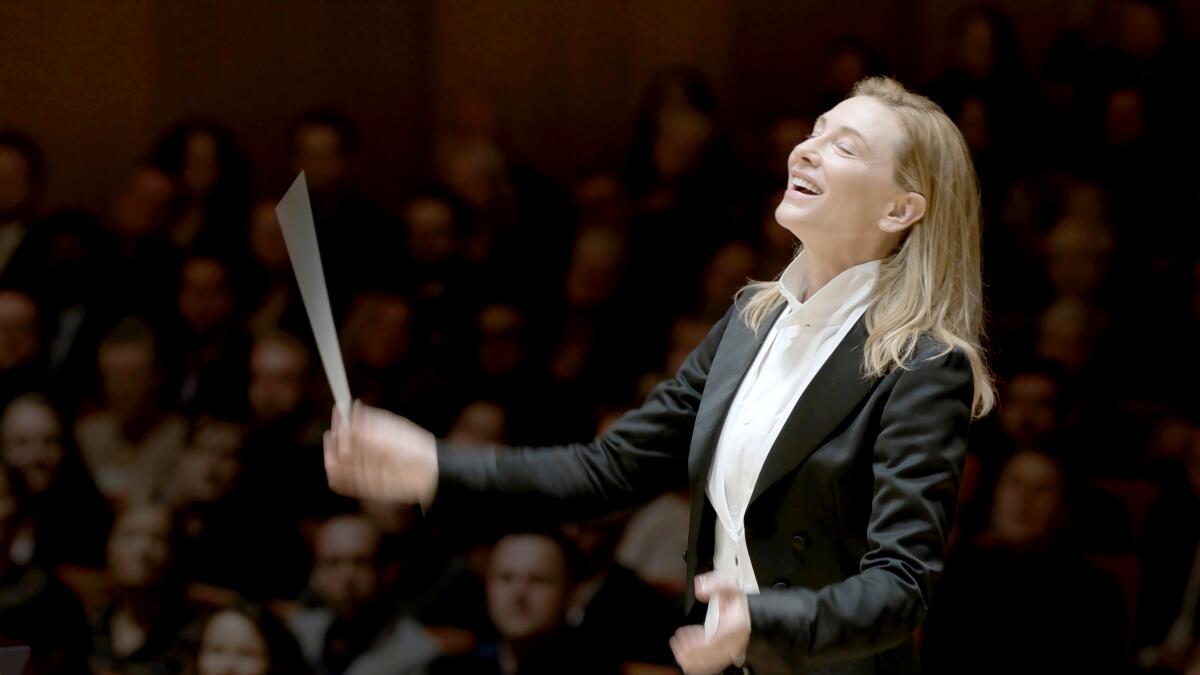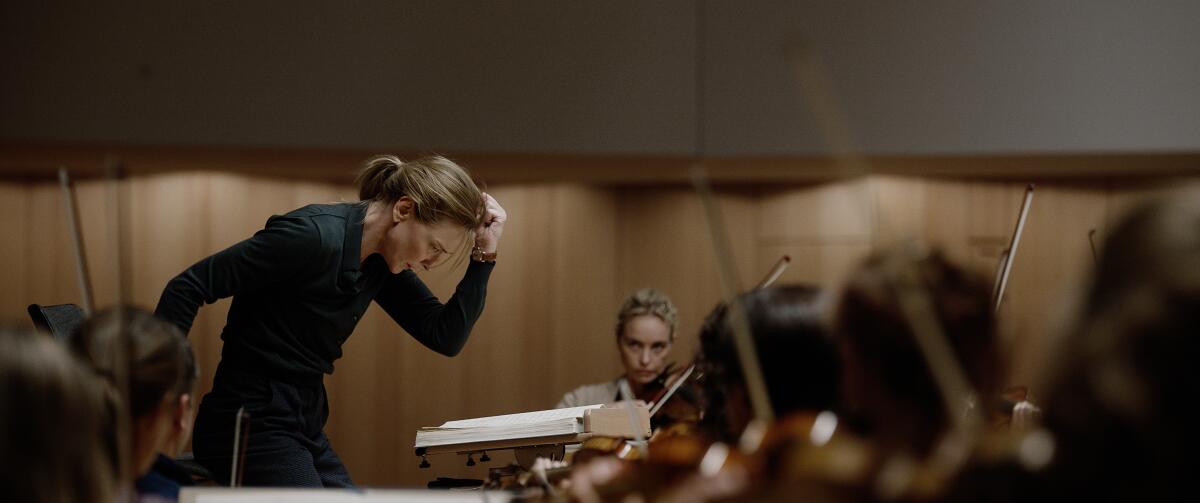Why are the end credits at the beginning of ‘Tár?’ Todd Field explains.

“I hate explaining this stuff.”
“Tár” is the first film written and directed by Todd Field in 16 years, so it is understandable that the filmmaker may be a little out of practice in spilling exactly what his work is about. But “Tár” is also a film very much made by its ambiguities, right from the very start as the film’s end credits play in full near the beginning.
The film centers around the character of Lydia Tár (played by Cate Blanchett), a fictional composer and conductor who feels far too believably real. An EGOT winner, celebrated by the likes of the New Yorker and NPR, she is on the verge of publishing a memoir titled “Tár on Tár,” and completing conducting a cycle of Mahler symphonies, both crowning achievements in her career. It all comes crashing down when years of abusing her power and privilege in ways great and small finally catch up with her.
Field is a three-time Oscar nominee, including nominations for the screenplays for his two previous films as director, 2001’s “In The Bedroom” and 2006’s “Little Children.” For “Tár,” he has already picked up a Gotham Award for the screenplay and seven Spirit Award nominations.
In his career as an actor before becoming a filmmaker, Field is perhaps best known for his role as Nick Nightingale, the piano player in “Eyes Wide Shut,” the last film made by Stanley Kubrick, who died in March of 1999 only months before its release. Starring Tom Cruise and Nicole Kidman, “Eyes Wide Shut” was met with confusion and a relative rejection when it was released. But over time it’s come to be embraced as a complex and beguiling work and even, due to its Christmastime setting, a new holiday classic.
“Tár” includes many shades of Kubrick throughout the film, from its center-focused compositions, seeming demand for repeat viewings and mixture of airtight formality and wild unpredictability. The way in which both Lydia Tár the character and “Tár” the film are so hard to pin down, refusing easy categorization or definition, is exactly what Field wanted. A scene in which Tár excoriates one of her students at Julliard in a way that, depending on a viewer’s perspective, makes her a hero or a villain — while questioning the very need for such definitions — encapsulates the strategies of the film.
“That was sort of the point of the film, to have some kind of punching bag for people to be able to fiercely express their feelings about things,” said Field. “The one thing that any storyteller will tell you — that it’s all good unless someone’s indifferent to it. As long as the conversation is hot and lively, that’s great. That’s what we all hoped for when we were making the film.”

The movie opens with an image on a camera phone that the audience has no context for yet, and then what are typically the end credits play out in full. I saw the movie at a public showing and the audience reaction moved from confusion to a palpable annoyance and even anger. What made you want to include the end credits at the beginning of the movie?
Todd Field: It’s always dangerous to talk about these things because I think that your ideas evolve. All I can tell you is that my very first line in the script for whatever reason, I didn’t think about it, I just wrote “punctuating credits, filling a single black frame one after the other side by side, like players seated on a cramped stage.” That’s what I wrote. I didn’t think about it very much, but I knew at that moment I was hoping to achieve kind of like an overture or a prelude. That idea evolved.
Here’s two things. One is we watch movies these days and unfortunately we watch too many of them at home. And when we get to those end credits, they shrink and they fly to the corner, and you scramble for your remote. And if you’re someone that works in the business because you want see who worked on the film, and especially if you know your friends worked on the film and who else worked on the film, and you’re genuinely curious. And if you’re going to credit people, then those credits should count as much as any other credits. Many are the hands that make a film. There are many filmmakers that lock arms together and so just simply speaking, I wanted to recalibrate the viewer’s expectations about hierarchy. That’s a fairly low-hanging piece of fruit thematically for the film.
But also to recalibrate how they listen and for what length of time. And in this case, with this song sung in a language 99.9% of them will not understand, so the Shipibo Conibo Icaro that’s sung by Elisa Vargas Fernandez, it’s representative of the ethnographic field work that both Adam Gopnick and Lydia Tár reference in the very first scene that follow those opening credits. And that’s important, whether you understand what it is or not, I think it’s important just in terms of sort of saying, “Get ready, the rhythm and hues that you’re used to perhaps may be a bit different going forward,” and intentionally try to put an audience on their heels and make them decide where they stand and if they stick with it or not. And it is disorienting, but intentionally so.
It was also that even though it’s a rehearsal film, there’s a tremendous amount of performance required, and if anyone came at the end other than the performers to take that curtain call, I’d be throwing fruit and tomatoes at the screen. So it was really important that they come out and we have the pleasure of letting them take a curtain call. So the rule being that the last is first in the beginning of the credits and the curtain call credits at the end of the film are meant exclusively for the onscreen performers and the three primary people who assisted those performers in the making of the music.
Those three people being our composer, Hildur Guðnadóttir; our music advisor, John Mauceri; and our conducting supervisor, Natalie Murray Beale. So it was a very simple decision. And [editor] Monika Willi and I, along with our apprentice editor, John Kolesnikow, created and slugged those credits from early on because they were very important. They weren’t just credits. We were hoping they were doing things that we wanted to achieve. And that anyone that saw the film, including the studio for the very first time, understood were facts having to do with the rhythm of the film. It was a big conversation after the first viewing with [distributor] Focus [Features]. We had to really talk about that, there was some real concern to your point, that people would be confused and they might be running to the projection booth and saying that you got reel eight where reel one should be and all of that. But that level of disorientation was intentional. You know, I probably said too much about it already.

So something like the Julliard scene, when Lydia is verbally attacking her student, do you have a concern of that scene being misinterpreted?
Todd Field: No, I don’t think there’s anyone that can misinterpret it. People will justify their feelings through anecdote and with global reductive generalizations as if you’re making a documentary about whatever they think a scene might be about or they think what your intent is about. Within that scene, there are two generations that are talking at each other, and the initial intent behind that scene, anyway, when I was writing it was really just asking Lydia Tár a question, which is: What would you say to your younger self if you could impart some wisdom, or what you believe is wisdom? When she graduated from Harvard, the kind of music she was playing was atonal, was experimental. She didn’t want to play dead white man music, but that’s where she is now. In essence, yes, they’re the trappings of hopefully some version of a present-day classroom. Although people will debate that too. They’ll say, “No, I’ve been in a classroom and it’s not like that,” and “People don’t talk like that,” and “They could have done this, and they could have done that” — that’s fine too. That’s their experience. That’s not mine. But the main thing is that she’s having a conversation with herself at 23, 24 years old and she’s making an attempt to convince that younger self of what a middle-aged version of that self believes. And is that valid? And does that matter even? Ultimately she’s unsuccessful in doing that and navigating that conversation.
But I feel differently about that scene than when I wrote it. I feel differently than when we were shooting it in different points, when I watched it with Monika Willi, depending on when we’ve watched it or how long it’s been since we’ve looked at that or the movie as a whole. I don’t think there’s a wrong way to read the scene. That scene is there for a reason, it’s a conversation starter. And again, that conversation may be not so polite, as she would say. And that’s OK.

If I can just ask about “Eyes Wide Shut” for a moment: The movie has become a new Christmas classic. It plays without fail during December now. And especially considering the way the movie was kind of rejected when it first came out, what has it meant to you to now see it be embraced?
Todd Field: I wish Stanley could have seen that. We lost him way too young. And he never really got to see how people responded to the film. In one way, that’s poetically perfect. He felt deeply that, at least at that moment in his life, he was convinced that it was the best film he ever made. And that would be a really nice feeling to go out with. And I think that feeling is more important than anything. I know it’s more important than anything.
So it’s interesting to see that people talk about that film and seem really deeply invested in it as a piece of cinema. And I think he would’ve been, anyone that would’ve made that film probably would’ve been really, really thrilled with that because that’s really the thing. Does the film stand the test of time? That’s what you always ask yourself. In 10 years, are people going to remember what you made? And chances are they won’t.
One last thing, in the scene in the 1994 movie “Sleep With Me” where Quentin Tarantino delivers his now famous monologue on the movie “Top Gun,” you are the person he delivers it to. Do you get a kick out of the fact that scene has such an enduring legacy, in particular in this year of another “Top Gun?”
Todd Field: Well, I mean, it is odd. First of all, I would encourage people to see that film, directed by Rory Kelly and written by a bunch of Rory’s filmmaking friends, Michael Steinberg and Neal Jimenez, who made the great “River’s Edge” and “Waterdance” and Duane Dell’Amico. All of them wrote a section of the film, Rory directed it, and starring Eric Stoltz, who’s excellent in it, and Meg Tilly and Craig Sheffer and many others. It was kind of a strange film because it was picked up by MGM when John Calley was running it for a second and marketed as this sort of rom-com, which it was anything but. And so it wasn’t widely seen and it didn’t really do the festival circuit or anything like that.
So Quentin came up that day and that was not the scene. The scene was, I was doing all the talking. If you can imagine anyone ever doing that with Quentin. And I knew Quentin a little bit ’cause I’d met him when he was casting “Reservoir Dogs.” So Quentin arrives, and he says, “Hey man, listen, I just had this idea just driving up here, man, I know you got the scene and everything, but let me just pitch this thing to you. Just let me do it for you. OK. Let me do it.” And so I said, “OK, man. Yeah, go ahead.” And so he does it, and I’m on the floor. We’re out on the sidewalk and I just, I said, “OK, that’s it. Yes. We definitely have to do that.” He goes, “OK man. So how, how are we gonna convince Rory about it? Cause he thinks you’re doing this other scene.” And I said, just leave that to me. So I go in and I said, I go, “Look, [cinematographer] Andrzej [Sekula], put the camera on your shoulder. Make sure that you have a full mag, ’cause this is long. And we’re just gonna do it.” And Rory’s like, “What are you guys gonna do?” I said, “Just trust me. Just let Quentin do it. It’s an over-the-shoulder on Quentin. Don’t look at me, just watch Quentin.” And so that was it. We rolled it. We did it in one take.
And of, of course, Quentin hadn’t just thought of that on the way up. That was a bit that he and Roger Avary used to do at the video store. It always worked. So Quentin knew he had that in his hip pocket. He knew it would be a winner. But it is funny that it’s out there now, and that it’s still out there and in a film that very few people saw. Especially this year, finally with Tom and Joe Kosinski coming out with the sequel. Odd coincidence.
More to Read
Only good movies
Get the Indie Focus newsletter, Mark Olsen's weekly guide to the world of cinema.
You may occasionally receive promotional content from the Los Angeles Times.











